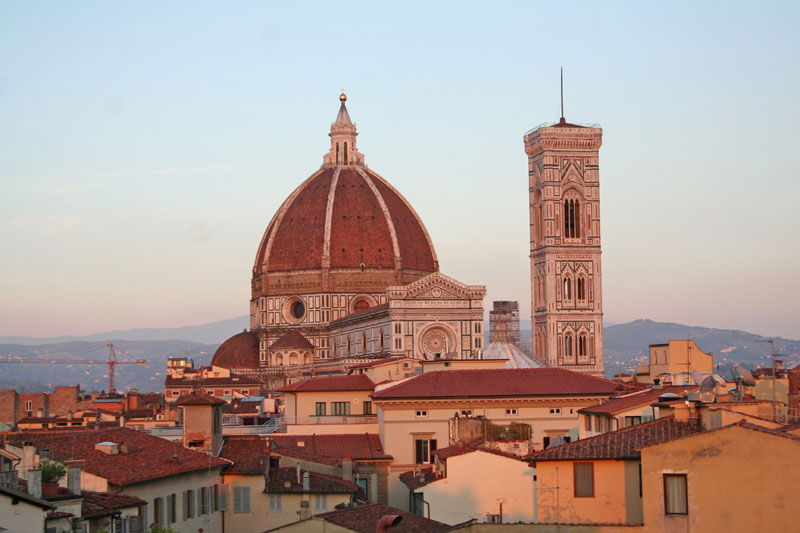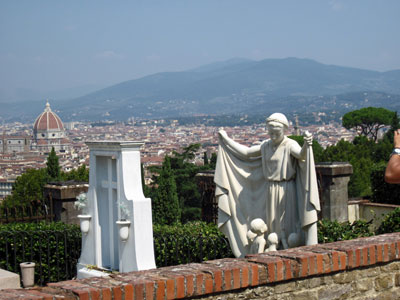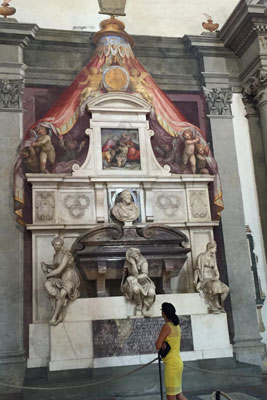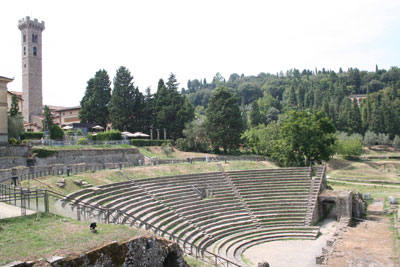Three fabulous days in Florence
This article appears on page 20 of the August 2016 issue.
Despite the 101-degree temperatures during our visit, my husband, Ray, and I packed everything feasible into a 3-day pre-cruise visit to Florence, Italy, Aug. 7-9, 2015.
Our “home” was the Hotel B4 Astoria Firenze (Via del Giglio, 9; www.b4astoriafirenze.com), a historic hotel created from two former residences of Florentine nobles. The breakfast room and lobby reflected this palatial past, and the rooftop bar offered impressive views of the Duomo, aka Santa Maria del Fiore.
Our spacious king room (No. 402) included a mini-fridge, slow Wi-Fi, a wide-screen TV, a desk and chair, a microscopic bathroom and another view of the Duomo. (A double room, including breakfast and VAT, ranges from E168 to E218, or $186-$242, per night.)
Its superb location far overshadowed its minor limitations. The Duomo, Basilica di San Lorenzo and Mercato Centrale all were only minutes away, as were numerous restaurants.
For example, at our favorite, Trattoria Il Porcospino (Piazza di Madonna degli Aldobrandini, 11/12r; www.il-porcospino.it), Ray ordered spaghetti mare (€14, or about $16) while I savored grilled salmon with a salad (€16).
We concluded every evening with the best gelato at Antica Gelateria Fiorentina (Via Faenza, 2A), located only three blocks from the hotel.
In and out of the city
Day one started with a guided walking tour of Renaissance Florence, beginning with a stop to see Michelangelo’s “David” at the Galleria dell’Accademia. We continued on, past Il Duomo, and concluded at Piazza della Signoria.
After the tour, we lingered in the piazza and watched street performers before returning to both Il Duomo and the Basilica di San Lorenzo for tours of their interiors.
Entry to Il Duomo was free, and the line was daunting. San Lorenzo required a €4.50 admission fee, but there was no line. Both enforced strict dress codes, requiring covered shoulders and shorts or skirts down to the knees.
For lunch, we dined on tuna pasta salad, panini and drinks (€18.50) at the self-serve Marchetti Stefania (Via Calzaiuoli 102R), near the Duomo. Economical and superb!
On our second day, we escaped the tourist crowds and headed for Fiesole, an ancient Etruscan/Roman village dating back to the 9th century BC. To get there, we rode public bus No. 7 toward Fiesole, originating at Piazza San Marco (the stop nearest the Galleria dell’Accademia) and concluding at Piazza Mino, Fiesole’s main square.
The bus runs every 20 minutes between 6 a.m. and midnight.
Tickets cost €2 each, purchased from the driver; however, had we purchased them in advance at a tabacchi, each would have cost only €1.25.
Upon boarding the bus, we time-stamped our tickets and enjoyed the 30-minute ride.
Our first stop was the tourist information office, located just off Piazza Mino at Via Portigiani 3, next to the Area Archeologica. Helpful staff provided walking maps and advice. Clean, free toilets were located just beyond the Area Archeologica ticket window but not inside the site. Across the street was a mini-mart selling cold water.
Spiritual stops
Our explorations began inside the dark and spiritual Romanesque Cattedrale di San Romolo with its massive bell tower. Organ music wafting through the air enhanced our visit.
Next, west of the cathedral, we found Via San Francesco, a steep, pedestrian-only street leading up to Convento di San Francesco, built on an ancient acropolis. The small, Gothic church featured Renaissance paintings and 14th-century wooden choir stalls.
A side door led us through a garden cloister to the small Franciscan Missionary Museum, with displays from the friars’ missionary work in China and Egypt.
Outside the church, to the left, was an entrance into another garden and stairs up to restored friar cubicles. Also outside, a pillared walkway led to great views of Fiesole and the gardens below.
The convent’s gift shop sold water and ice cream.
Due to the heat and the time, we opted to not explore the gardens nor walk the Etruscan walls. Instead, we descended Via San Francesco back to Piazza Mino. Unfortunately, we were so focused on the amazing panoramic views of Fiesole and Florence that we missed the 6th-century Chiesa di Sant’Alessandro en route.
Our next stop was Area Archeologica (Via Portigiani 1). We decided to visit only the site and not the Bandini Museum next door; we paid €7 each for entry plus English audio guides and headphones.
The audio guides led us from the partially restored Roman amphitheater to remains of an Etruscan temple and Roman baths. We learned that while the Etruscan settlement probably dates back to the ninth to eighth centuries BC, its first historical record dates from when it was conquered by the Romans in the third century BC.
Following a late lunch at one of the many restaurants on Piazza Mino, we explored the piazza, itself, including the bronze statue “L’incontro di Teano” and the tiny Church of Santa Maria Primerana, the latter dating back to AD 966, then we caught the bus back to Piazza San Marco. It was a delightful day away from the masses!
A sweet surprise
Our final day in Florence was a blend of planned exploration and serendipity. We boarded the public bus No. 12 at Santa Maria Novella, near the railway station, for a 20-minute scenic ride across the River Arno and through Viale dei Colli, a green residential area, before disembarking at Piazzale Michelangelo, the famous terrace overlooking the Old City. From the piazzale, we saw the “postcard” panoramic view of Florence.
Next we walked up past the Church of San Salvatore al Monte and continued up a footpath to the side entrance of San Miniato al Monte, considered one of the most unspoiled of Romanesque churches in Tuscany.
Its facade, begun around 1090, featured a geometric pattern in green, gray and white marble. Church services were under way, so we explored only the cemetery surrounding the church.
Exiting the church grounds down the stairs through the main entrance, we followed Via del Monte alle Croce through the city gates and toward the Basilica of Santa Croce. Along the way, we passed green countryside and old city walls.
After a salad lunch at Oibò Café Ristorante (Borgo de’Greci 1) for €23.50 ($26.50), we entered the magnificent Gothic Basilica of Santa Croce, most noted for its tombs of famous Florentines, including Michelangelo and Galileo. We anticipated staying only a couple of hours but remained for four. There was so much to see!
Admission cost €6 each, and a strict dress code was enforced. Their 50-cent map proved invaluable in identifying the tombs as well as the frescoes, paintings and sculptures throughout the grounds.
From Santa Croce, we meandered back toward Il Duomo and accidentally discovered Magnum Firenze (Piazza del Duomo 47), across from a rear corner of the Duomo, where customers could design their own Magnum ice cream bars. Since we love Magnum bars, we each had great fun creating our own (€4.50 each).
First we selected the ice cream: vanilla or chocolate. Then we picked three from a multitude of toppings, such as raspberry crunch, crushed nuts and chocolate sprinkles. Next we chose the outer chocolate coating — dark, white or milk — and, finally, another chocolate topping to dribble over our creations.
Staff completed our unique Magnum bars while we drooled with anticipation.
This was the perfect serendipitous conclusion to a busy day — and a fine end to our three days in Florence.




